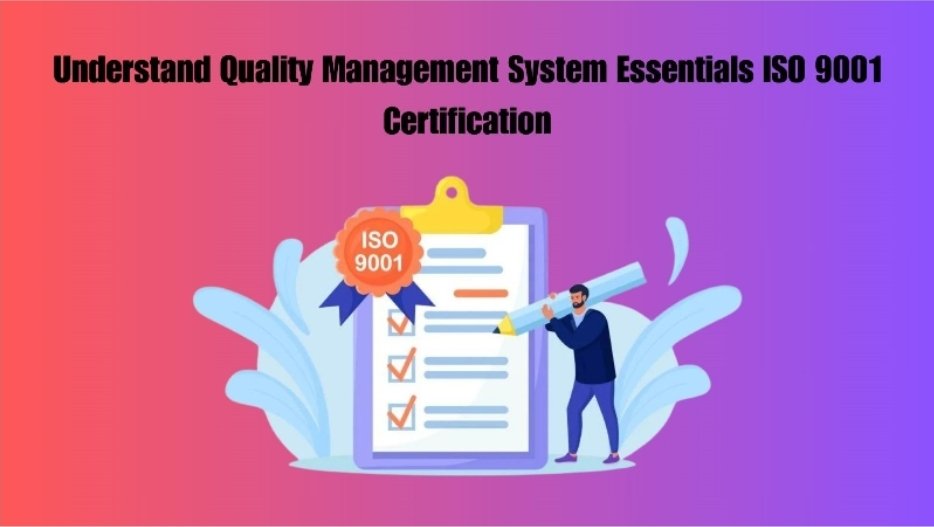Understand Quality Management System Essentials ISO 9001 Certification

As one of the vital principles in the modern enterprise culture, quality can positively influence consumer relationships. The fundamental part of the mentioned certification is preferably the provision of a QMS that has been established on the ISO 9001 Requirements. Completing ISO 9001 Courses and meeting all consequent requirements is necessary for obtaining both ISO 9001 implementation and conformance with ISO 9001 standards at the same time. Let’s look at the basics of ISO 9001 certification, its importance, and how companies can use it to raise customer satisfaction, management, and overall efficiency in this blog.
Table of Content
- Understanding ISO 9001 Certification
- Key Principles of ISO 9001
- Implementing ISO 9001 Step-by-Step
- Benefits of ISO 9001 Certification
- Challenges and Solutions in ISO 9001 Implementation
- Constant Improvement
- Conclusion
Understanding ISO 9001 Certification
ISO 9001 certification, one of major quality management standards, calls for organisations to have systems that define, establish, enforce, monitor and continuously improve their Quality Management Systems so that they are fully in compliance with this standard. It defines the needs of a QMS, stressing upon the concept of Customer focus, Leadership, Process approach, and Constant growth. The attainment of ISO 9001 certification by an organisation demonstrates the organisation’s seriousness in service quality, customer retention, and full compliance with the statutory and regulatory requirements.
Key Principles of ISO 9001
The ISO 9001 standard consists of several guiding principles for organisations on the way to operational perfection. These guidelines are customer centricity, leadership, engagement with people, process approach, and constant growth, teams with data-based decision making, and relationship management. By implementing principles of quality, efficiency and sustainability, companies can stimulate a culture of quality, improve efficiency and yield long-term achievements.
Implementing ISO 9001 Step-by-Step
ISO 9001 implementation will necessarily follow the principle of systemic arranging of all activities under a systematic Quality Management System. The procedure usually starts with a vulnerability analysis aimed at determining the shortcomings of the current processes regarding ISO 9001 requirements. After that, the organisations establish their quality policy, objectives, and procedures together with the provision of procedure manuals to guide the implementation of the stipulated quality controls.
Training and awareness programs ensure that employees are versed in what it means for them in the context of the QMS. Through continuous checking, evaluating, and testing, any opportunities for improvement are identified, which then allows for corrective actions and preventive procedures to be taken.
Benefits of ISO 9001 Certification
Certification of ISO-9001 implies a panoply of advantages for businesses of different types. It boosts the trust and authenticity of the organisation, its customers and stakeholders, hence leading to more business opportunities and market share. The general benefits that can be gained from improved consistency, efficiency and cut in costs due to streamlined procedures and materials utilisation. Customer trust and ongoing affiliation are developed with a concentration on meeting expectations and delivering quality service. Furthermore, ISO 9001 certification provides a platform for the establishment of an improvement climate and facilitating innovation, thus helping to gain a competitive edge in the global marketplace.
Challenges and Solutions in ISO 9001 Implementation
Implementation of ISO 9001 despite having a lot of opportunities, it is faced with a few downfalls such as the fact that people are resistant to change, resource constraints and documentation complexity among others. However, the task isn’t easy but strong leadership, effective communication and employee engagement are the key factors to overcome these hindrances. Allowing the time for training and support facilitates cooperation and the implementation of standards ISO 9001. Among other things, applying technology to processing automation and data management simplifies QMS installation and maintenance.
Constant Improvement
Implementing ISO 9001 is a long journey, and the achievement by making the certification sustainable is a set point to continue improving. Management systems must have overall reviews and audits to see how the system is effective and appropriate with changing business requirements. The customers, employees, and other interest holders’ observation counts which areas could be improved. Through the process of learning and adapting, organisations can navigate and stay ahead of market trends and regulatory landscape requirements thereby setting themselves up for future prosperity.
Conclusion
In conclusion, ISO 9001 certification is a guiding star of quality management excellence that helps businesses to improve or develop customer satisfaction and only then drives operation efficiency and sustainable growth. Implementing the key components of the ISO 9001 and following its requirements will empower businesses to maximise their benefits of a quality management system, while establishing themselves as leaders in the modern day’s marketplace.






